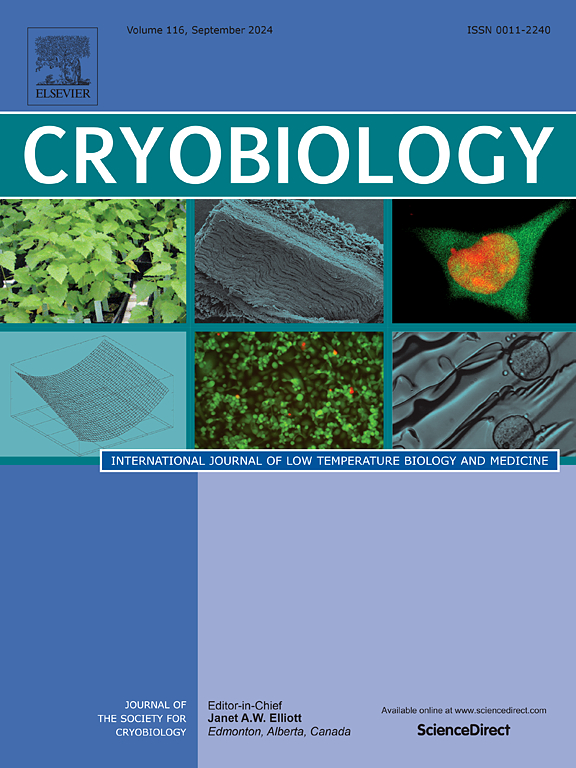Conjugates of gold nanoparticles and antifreeze protein III for cryopreservation of cells and tissues
IF 2.1
3区 生物学
Q2 BIOLOGY
引用次数: 0
Abstract
The development of non-toxic cryoprotectants is crucial for advancing fields such as regenerative medicine, cell therapy and tissue engineering, where the preservation of the viability of cells, tissues and organs during cryopreservation is essential. This interdisciplinary effort involves areas such as cryobiology, nanotechnology, biochemistry and material science to create more efficient and safer cryoprotective solutions. This study explores the development and application of gold nanoparticles (AuNPs) conjugated with antifreeze protein III (AFPIII) for improving the cryopreservation of bone marrow stem cells (bMSCs) encapsulated in alginate macrospheres (AMSs). Two types of AuNPs, stabilized with citrate (CitAuNPs) and BSPP (BSPPAuNPs), were functionalized with AFPIII using both covalent and non-covalent conjugation methods and were characterized for their size, surface charge and protein layer thickness. The cytotoxicity assays indicated that both types of AuNPs and their AFPIII conjugates had no adverse effects on bMSC viability and proliferation over 48 h, demonstrating their non-toxicity. Furthermore, the cryopreservation of bMSC-contained AMSs revealed that the covalent BSPPAuNPs-AFPIII conjugate provided superior preservation of cell viability and metabolic activity, outperforming both non-covalent conjugates and individual components. Cryomicroscopic analysis revealed that AFPIII altered ice crystal formation, promoting smaller, multidirectional crystals, which minimized cellular damage during freezing. The covalent BSPPAuNPs-AFPIII conjugate exhibited superior cryoprotective effects, preserving cell viability and function better than the non-covalent CitAuNPs-AFPIII conjugate. These findings suggest that AuNPs-AFPIII conjugates, particularly the covalent BSPPAuNPs-AFPIII complex, hold great promise for improving cell and tissue cryopreservation protocols.
用于细胞和组织冷冻保存的金纳米颗粒和抗冻蛋白III的缀合物
无毒冷冻保护剂的开发对于再生医学、细胞治疗和组织工程等领域的发展至关重要,在这些领域中,在冷冻保存过程中保存细胞、组织和器官的活力是必不可少的。这项跨学科的努力涉及低温生物学、纳米技术、生物化学和材料科学等领域,以创造更有效和更安全的低温保护解决方案。本研究探讨了结合抗冻蛋白III (AFPIII)的金纳米颗粒(AuNPs)的开发和应用,以改善海藻酸盐大球(ams)包封的骨髓干细胞(bMSCs)的低温保存。用柠檬酸盐(CitAuNPs)和BSPP (BSPPAuNPs)稳定的两种类型的AuNPs,分别用共价和非共价偶联方法与AFPIII进行了功能化,并对其大小、表面电荷和蛋白层厚度进行了表征。细胞毒性实验表明,这两种类型的AuNPs及其AFPIII偶联物在48小时内对bMSC的活力和增殖没有不良影响,表明它们是无毒的。此外,对含有骨髓间质干细胞的AMSs的冷冻保存表明,共价BSPPAuNPs-AFPIII偶联物在保存细胞活力和代谢活性方面优于非共价偶联物和单个组分。低温显微镜分析显示,AFPIII改变了冰晶的形成,促进了更小的、多向的晶体,从而最大限度地减少了冷冻过程中的细胞损伤。与非共价的CitAuNPs-AFPIII偶联物相比,共价的BSPPAuNPs-AFPIII偶联物具有更好的冷冻保护作用,能更好地保持细胞活力和功能。这些发现表明,AuNPs-AFPIII缀合物,特别是共价的BSPPAuNPs-AFPIII复合物,在改善细胞和组织冷冻保存方案方面具有很大的希望。
本文章由计算机程序翻译,如有差异,请以英文原文为准。
求助全文
约1分钟内获得全文
求助全文
来源期刊

Cryobiology
生物-生理学
CiteScore
5.40
自引率
7.40%
发文量
71
审稿时长
56 days
期刊介绍:
Cryobiology: International Journal of Low Temperature Biology and Medicine publishes research articles on all aspects of low temperature biology and medicine.
Research Areas include:
• Cryoprotective additives and their pharmacological actions
• Cryosurgery
• Freeze-drying
• Freezing
• Frost hardiness in plants
• Hibernation
• Hypothermia
• Medical applications of reduced temperature
• Perfusion of organs
• All pertinent methodologies
Cryobiology is the official journal of the Society for Cryobiology.
 求助内容:
求助内容: 应助结果提醒方式:
应助结果提醒方式:


